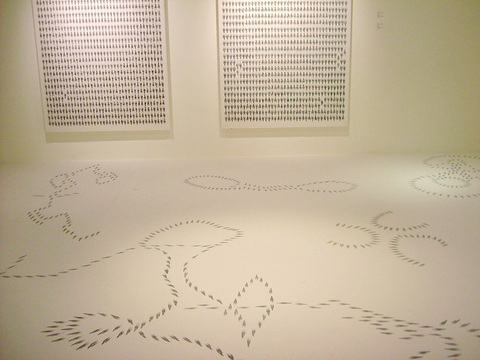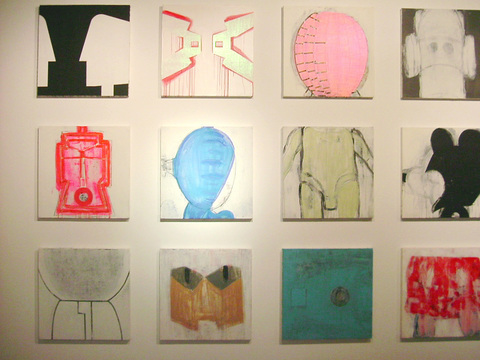Displaying modern art is straightforward for many museums as exhibitions generally only require white walls for framed paintings and pedestals for sculpture. Contemporary art, on the other hand, requires an entirely different treatment as the media, ideas and presentation drastically differ from traditional modes of art.
Taipei's Museum of Contemporary Art [MOCA] is solely designed to display new forms of art such as video projection, digital art, installation and performance work.
Currently on view is A Glimpse of Contemporary Art with work from seven local artists who have each been assigned a room to exhibit in.

PHOTOS: SUSAN KENDZULAK
The building was once a school, so the rooms still have an intimate, yet cramped atmosphere -- the separateness of the rooms also creates a sense of isolation.
The exhibition aims to give the uninitiated an overview of Taiwan's art scene.
Most of the art has been exhibited previously in other spaces and has now been assembled as a sampler of paintings, installations and video works that includes the work of prominent digital artists Wang Jun-jieh (

Wang's darkened room shows his double-screen projection of film-noir-like imagery which evokes a narrative. A dapper man turns a door knob; blood flows on the floor and a crate of oranges glows. Yuan's popular video Floating is shown in a passageway on a computer screen and in a separate pitch-black room a loud humming sound is heard while a rectangular-shape can be faintly discerned in a work titled The Moving Luminous Space.
Murky landscape paintings from locally acclaimed painter Su Wong-shen (
Lai Chiu-chen (賴九岑) disassembled toys into little pieces and then enlarged these unidentifiable parts into large painted imagery. The canvasses, arranged in a grid, then give the appearance of an archeological discovery or a creation of a new abstract form, when in fact Lai is just transforming an invisible object into a visible one.

While tackling notions of Taiwanese identity Shy Gong (施工) and Hou Chun-ming (侯俊明) defy categorization as they follow their own unique perceptions of the world. Gong debuts his IMO Design group creating innovative living solutions. Hou has gained notoriety for his raw woodblock prints of sexual and shamanistic imagery. Here, his in-your-face black and white graphic imagery is framed in a blood-red room.
Thematically there is nothing to tie these artists together other than they are all local male artists. The lack of insight from female artists could make it seem that Taiwan's contemporary art does not include female artists.
What: A Glimpse of Contemporary Art in Taiwan

Where: Museum of Contemporary Art (台北當代藝術館), 39 Changan W Rd (台北市長安西路39號)
Telephone: (02) 2552 3721
When: Tue to Sun; 10am to 6pm; until June 4
On the net: www.mocataipei.org.tw

In the March 9 edition of the Taipei Times a piece by Ninon Godefroy ran with the headine “The quiet, gentle rhythm of Taiwan.” It started with the line “Taiwan is a small, humble place. There is no Eiffel Tower, no pyramids — no singular attraction that draws the world’s attention.” I laughed out loud at that. This was out of no disrespect for the author or the piece, which made some interesting analogies and good points about how both Din Tai Fung’s and Taiwan Semiconductor Manufacturing Co’s (TSMC, 台積電) meticulous attention to detail and quality are not quite up to

April 21 to April 27 Hsieh Er’s (謝娥) political fortunes were rising fast after she got out of jail and joined the Chinese Nationalist Party (KMT) in December 1945. Not only did she hold key positions in various committees, she was elected the only woman on the Taipei City Council and headed to Nanjing in 1946 as the sole Taiwanese female representative to the National Constituent Assembly. With the support of first lady Soong May-ling (宋美齡), she started the Taipei Women’s Association and Taiwan Provincial Women’s Association, where she

It is one of the more remarkable facts of Taiwan history that it was never occupied or claimed by any of the numerous kingdoms of southern China — Han or otherwise — that lay just across the water from it. None of their brilliant ministers ever discovered that Taiwan was a “core interest” of the state whose annexation was “inevitable.” As Paul Kua notes in an excellent monograph laying out how the Portuguese gave Taiwan the name “Formosa,” the first Europeans to express an interest in occupying Taiwan were the Spanish. Tonio Andrade in his seminal work, How Taiwan Became Chinese,

Mongolian influencer Anudari Daarya looks effortlessly glamorous and carefree in her social media posts — but the classically trained pianist’s road to acceptance as a transgender artist has been anything but easy. She is one of a growing number of Mongolian LGBTQ youth challenging stereotypes and fighting for acceptance through media representation in the socially conservative country. LGBTQ Mongolians often hide their identities from their employers and colleagues for fear of discrimination, with a survey by the non-profit LGBT Centre Mongolia showing that only 20 percent of people felt comfortable coming out at work. Daarya, 25, said she has faced discrimination since she